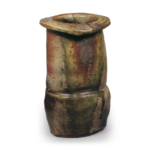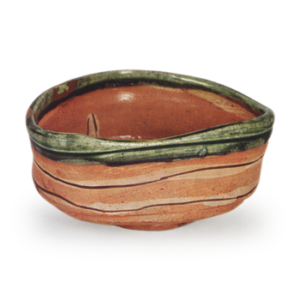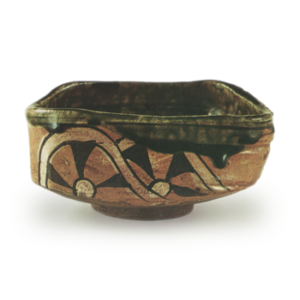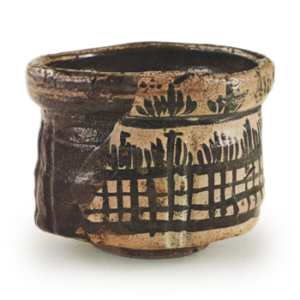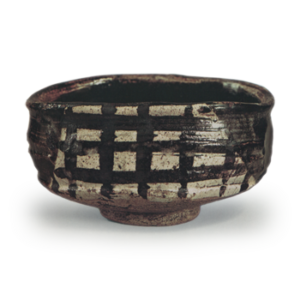Iga pottery produced before the early Momoyama period seems to bear little resemblance to Shigaraki. However, the pure tea ceremony ware Iga fired after the Momoyama period is quite different in style from the Shigaraki of that time. It is estimated that these ceramics were fired at the Makiyama Kiln in Kadokei, Mie Prefecture, the Marubashira Kiln in Mie Prefecture, and the kiln in Iga Ueno Castle, and the following account by Todo Motoho in his Sangoku Chishi (A Geographical Description of the Three Countries), published in Horeki 13, describes the history of these kilns
The pottery is made in Marubashira Village and is called Iga ware by some. It was produced in Marubashira Village in the old days in Makiyama Village. They are tea jars, water jars, tea bowls, flower vases, and sake bottles. Tea pots, water jars, teapots, bowls, vases, and wine bottles. Some call them kisan-kettles. It is also called “Yamadote” (meaning “mountain way hand”). There is also one called Yamadote, which was fired at the time of Sadatsugu Tsutsui, and another called Ashita-yaki. These are all called old Iga. Most of them are similar to Shigaraki ware. Iga ware is a type of pottery similar to Shigaraki ware in Koshu.
According to this, Iga ware was mainly produced at Marubashira, and during the reign of Tsutsui Sadatsugu, it was also produced at Makiyama Kiln, and some of it was called Ashita ware. It seems that the Marubashira kiln was the main kiln during the Todo period and the Makiyama kiln during the Tsutsui period, but there is no mention of the old kilns in Iga-Ueno Castle, which are assumed to have been used by the Tsutsui family. The remains of the old kilns in the castle were probably buried underground during the Horeki period (1751-64), and there were no records of them.
As mentioned above, the local journal mentions “Tsutsui Sadatsugu no Toki Pottery,” but judging from its style, tea ceremony ware such as flower vases and water jars were probably produced after Tsutsui Junkei’s son Sadatsugu became lord of Iga in 1585, and old grade jars called Ashita ware, which is similar to Koshigaraki, were produced before that. It is likely that old pots called asita-yaki, similar to koshigaraki, were fired before the Muromachi period. Although we do not know for sure, it is likely that the Makiyama kiln was the main kiln used for pottery in the beginning, and later a kiln was built in Iga-Ueno Castle, where Sadatsugu resided, and pottery was produced there. It is estimated that most of the tea ceremony pottery Iga ware was produced at Makiyama, inside the castle, and at Marubashira for 24 years from the end of the Tensho period to the Bunroku and Keicho periods, until Tsutsui Sadatsugu was deposed in June 1608.
The fact that Sen no Rikyu and Furuta Oribe were involved in pottery production during this period, and that they were closely connected with Furuta Oribe is evidenced by Oribe’s letter to Ono Masanobu, which was attached to an Iga water jar called “Habukuro” that had been handed down in the Todo family, and which states that he would give the promised Iga water jar, but that he should be patient with cracks in it. The cracks are obvious. Furthermore, according to Furuta Oribe’s tea ceremony notes, all of the Iga ware water jars and flower vases used seven times between 1601 and 1683 were also from Tsutsui Iga. During the construction of the waterworks in 1935, pottery shards and kiln tools were excavated from the old kiln site in Ueno Castle, clearly indicating that it was a kiln site, and a nock-shaped water jar, a heavy cake-shaped water jar, and a flower vase were excavated. The Makiyama kiln site was discovered by the late Kikuyama Tounenghu, a resident of Uenokin, who also excavated a water jar with a spatula-shaped arrowhead design and a flower vase with ears, both of which are thought to date from the late Tensho period or later, based on the style of the pottery.
After Tsutsui Sadatsugu was deposed, Todo Takatora became the lord of Iga and the eight counties of Ise. He is said to have settled in Tsu and renovated Iga-Ueno Castle.
I assume that the ruins of old kilns in Ueno Castle belonged to the Tsutsui period, but there is also a theory that they belonged to the Todo period. However, since the Tsutsui clan was dissolved after the re-election, it is inevitable that there are no records left behind, but there should be some records of the Todo clan, but there are no records of them at all. The history of Iga pottery itself, not only in the castle kiln but also during Takatora’s reign from 1608 to 1630, is not known. Since a tea bowl with an inscription of 1623 is still extant, it is certain that tea ware was fired at Marubashira during Takatora’s reign, but since it is a shoe-shaped tea bowl with an ash glaze already applied, it is more reasonable to assume that after the Tsutsui clan was defeated, the style of pottery changed while the same type of pottery as that of old Iga was produced during Takatora’s reign. After the Tsutsui clan’s surrender, it is more reasonable to think that Takatora and Oribe Furuta When Oribe was ordered to commit seppuku by the shogunate in 1615, Takatora went to Oribe’s residence in Horikawa Sanjo Minami, Kyoto, and confiscated all of his tea utensils, which he later gave to his son-in-law, Kobori Enshu, This makes it all the more impressive to think that he was close to Oribe and Enshu.
As mentioned above, there is no record of Takatora’s reign, but there is an old document in the Todo family that clearly describes Iga pottery made during the reign of Takatsugu, the second lord of the domain. The document states, “In the spring of the 12th year of the Kan’ei Era (the 12th year of the Tokugawa shogunate), in the spring of the second year of the Tokugawa shogunate, a water jar from Marubashira Village in Iju was made by the Lord’s favor, and potters Magobei and Denzo of Sanjo, Kyoto were hired to learn how to control the fire. The following year, in the 13th year of the Kan’ei Era, when the Daitu-in-sama was visiting Iju, he visited the Marubashira Village on the right to see the specifications of the pottery. This article is found in the history book of Gizaemon Kano and Nobudo” (both from a book written by Michizo Kitamura). It is interesting to note that the potters Magobei and Denzo from Kyoto were invited to make this pottery, and naturally the style of the pottery must have been influenced by the Kyoto pottery style, and the water jars and other similar wares, which Enshu is said to have favored, may indicate some aspects of the style of the Takatsugu period, However, the full picture is also elusive. However, if we consider the tastes of the period, it is clear that they were quite different from those of the pre-Keicho Ko-Iga. It is not likely that Marubashira only produced tea ceramics during this period, as the “Sangoku Chishiki” (Sangoku Chishiki) states: “…… When the former sovereign, Takatsugu Odori, was in charge, he ordered that a water jar be made. The water jar was made by order of the sovereign. It is a treasured possession of the sovereign’s family. All of them are to be kept in the treasury of the sovereign’s house. It is thought that the clan’s printed wares were distinguished from ordinary wares by the phrase, “This is called goya-gama, or sen-nin tokuri.
It is not clear how long the Todo Iga continued after the Takatsugu period, but a record of the Todo family, also by Kitamura Michizo, states, “On the 12th day of the 7th month in the western year of the 9th year of the Kanbun period, there was a letter from the Imperial Armor Office on the right upper envelope in the Marubashira Shirado Mountain in Iga Province, and I saw his letter. He also stored the clay in his storehouse. The right side of the mountain is designated as Tomeyama,” which indicates that it was designated as Tomeyama before 1669. Furthermore, in a record written by Morita Kyuemon, a potter of Odo-yaki in Tosa Province, who made a tour of kilns in various countries, he wrote that when he visited Shigaraki in September 1678, he heard from Zen’ibei, a village headman in Nagano in the same area, that “pottery was made at a place called Marubashira, and that it was made for 40 years ago, but not recently. It is assumed that the kiln at Marubashira was finished around 1638, but the exact date when the kiln was turned over to the Otoriyama is not known.
However, a review of the existing works shows that they can be classified into three types based on their style and the state of firing of the clay, and that some of the works in the Momoyama period style seem to have been made from the same clay as that of Shigaraki, the wood-fired clay of Mt. This suggests that not all of them were made using clay from the Hakudo Mountains, which is considered a characteristic of Momoyama period Iga. There are also subtle changes in style, but it is not clear whether these are due to differences in time or differences between the Makiyama and Marubashira kilns. However, I believe that most of the strong Momoyama-style vases and water jars were fired between 1585 (the late Tensho period) and 1608 (the late Keicho period), which can be considered the Tsutsui period.
Flower vases were the mainstay of Iga ware produced from the late Tensho period to the early Edo period, and they are among the most important pieces of Momoyama period tea ceremony ceramics, and probably the most outstanding of all vases produced for tea ceremonies. When used in a small grass room, they create a uniquely solemn atmosphere, and even today they are highly valued among sukiya (connoisseurs of the tea ceremony). Although the basic techniques are the same, each piece is unique, and no two pieces have the same shape, which is one aspect of the character of Iga ware. In other words, this shows that Iga ware was not mass-produced, but was made to special order and produced as a purely tea ceremony ware. Moreover, the thorough firing in the kiln is something that could not be achieved in any other kiln, and this is where the character of the kiln as a purveyor to the lord of the domain can be seen.
Iga ware flower vases first appear in a tea ceremony chronicle on the ninth day of the first month in 1602, as recorded in Furuta Oribe’s Jikai-ki. However, in the “Kogo-no-Maki” section of Nanpo-Roku, vol. 7, it is written that Sen no Rikyu used an Iga-yaki flower vase for a tea ceremony to which he invited Takeo Shao’o. If this is the case, it would imply that Shao’o had died. If this is true, then the tea ceremony took place before Shaowo’s death in 1555, but the Nanbouroku is not a primary source, and there is no mention of Iga ware flower vases in any of the other major tea ceremony records. However, we cannot accept the description as it is. If this is the case, then The earliest record is the “Iga triangular tube vase” used by Oribe Furuta on the ninth day of the first month of the seventh year of the Keicho Era. The year Keicho 7 was the time when Tsutsui Sadatsugu (son of Junkei) was the lord of Iga, and it is assumed that Oribe had already had a relationship with Iga ware at that time and had them produce an artificial triangular flower vase. However, since Tsutsui Sadatsugu became a lord in 1585, it is thought that tea ceremony Iga ware had already begun to be produced during the Tensho period, and this is supported by a vase that belonged to Sen no Rikyu, who died in 1591. The shape of the vase is not as artificial as the series of vases said to have been Oribe’s favorites, but rather a simple cylindrical shape that suggests that it may have been Rikyu’s favorite. Since “Ikume” was owned by Oribe Furuta, it is generally assumed that Oribe preferred this type of vase, but when Oribe Furuta gave this vase to someone, he regretted it by saying, “I will not accept a vase with a flower canister. I also believe that this type of vase was made in the early style of Momoyama period Iga flower vases, but I would like to wait for further research on this.
However, most of the extant pieces seem to have been fired during the Keicho period (1596-1596). It seems that the peak of their production period was around Keicho 6 or 7, when flower vases and water jars made of Iga ware were mentioned in the “Koori Chakai Ki” (Records of Tea Ceremonies). It is estimated that it was around the fourth or fifth year of Keicho that Oribe’s favorite Kutsu tea bowls with strong distortions began to be produced in Mino, and it was around this time that Bizen ware, similar in style to Iga flower vases and water jars, also began to be produced.
Iga ware, with its dynamic style, has the largest number of flower vases extant, indicating that the main focus of its production was on flower vases. Those who used these vessels in Orebi tea rooms would understand that the most appropriate vessels for Iga ware, which is heavily naturally glazed, are flower vases and water jars.
Along with flower vases, mizusashi are also representative of Iga ware. It is likely that they were produced from the late Tensho period through the Bunroku and Keicho periods, as well as the Genna and Kan’ei periods, and many of their vessels have the so-called “Oribe-like” shape. The style of mizusashi also shows a commonality, with the pouch, gourd, and heavy rice cake shapes as the standard, each with its own variations. However, after the Todo clan became the feudal lord, especially in the early Edo period, they began to produce wares in the Enshu style, which was considerably different from the Oribe style of the earlier period. Even after Todo’s rule, however, Oribe-style pottery is thought to have continued to be produced during the Keicho period, and although there are names for Tsutsui Iga and Todo Iga, it is difficult today to clearly distinguish between the two.
Furthermore, it seems that before the Tensho period, Iga ware vases were made almost identically to Shigaraki ware, making it extremely difficult to determine the difference between Iga and Shigaraki ware. However, from the late Tensho period. Iga began to produce thicker, unique wares, and there are still quite a few jars of a different style from Shigaraki ware. It is thought that these jars were probably made for tea ceremonies.
Compared to flower vases, water jars, and jars, there are fewer tea caddies, incense containers, tea bowls, and pots, and their styles are less attractive than those of the former. Among them, the Kyanseki-shaped incense containers are well-known among the curious, but few of them are of excellent workmanship. Kutsu-shape tea bowls and bowls are also highly valued, but they are not as attractive as flower vases and water jars. Since a kutsu-shape tea bowl with an inscription of Genna 9 has been found, it must have been popular in the early Edo period.
The same type of Iga ware was produced at kilns in Mino such as Motoyashiki, which is called Mino Iga. Since both Mino and Iga are representative kilns that produced tea ceramics favored by Oribe, it is not surprising that similar works were produced at both kilns. However, because Mino Iga ware is fired in a climbing kiln, it lacks the dynamic glaze colors of Iga ware, which is made in a non-hyogen kiln.

